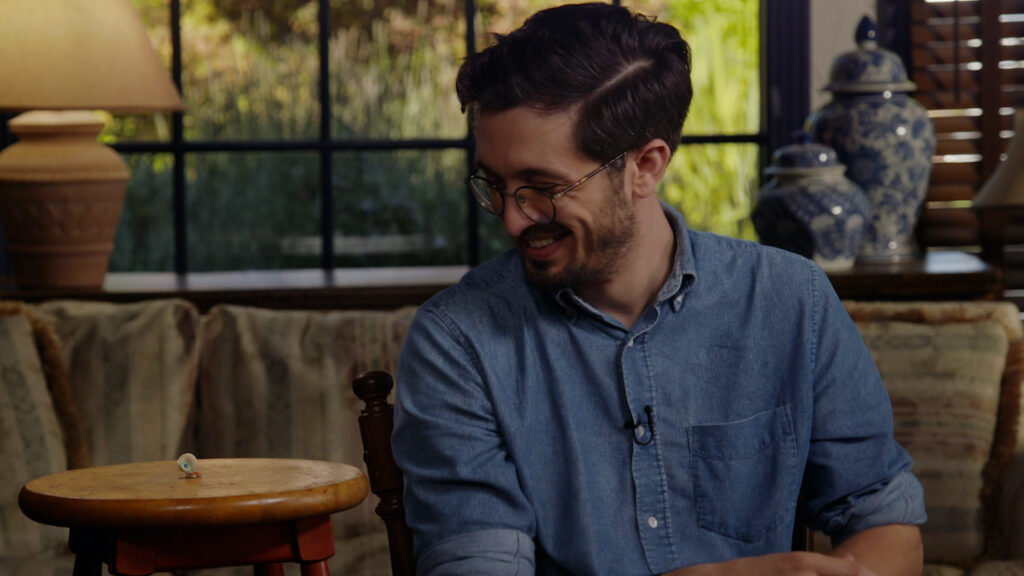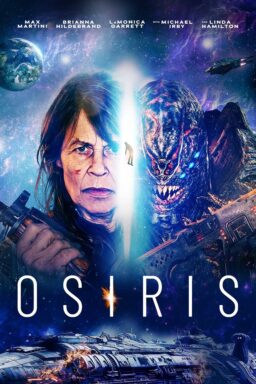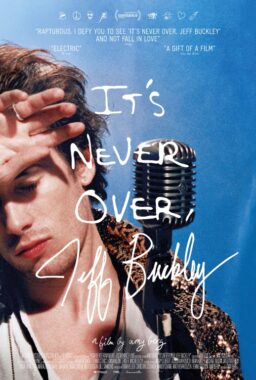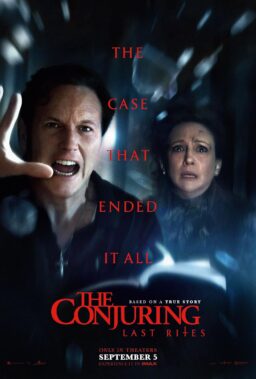In 2010, Dean Fleischer Camp and Jenny Slate made a short film about Marcel, a talking shell with one eye and little shoes. The endearingly cheerful little character became a viral hit, leading to more short films and two books. The two have now collaborated on a feature adaptation “Marcel the Shell with Shoes On,” in which Slate continues to voice the title character.
In an interview with RogerEbert.com, Camp spoke about the painstaking process of creating a feature film that combines elements of documentary, narrative feature, improvisation, and two forms of animation, how Marcel’s co-stars Isabella Rosellini and “60 Minutes” journalist Lesley Stahl got involved, and what he hopes Marcel the Shell With Shoes On will do next.

First, I want to talk just about the mechanics of this film. I understand that you essentially had to make it four times.
For a director on this project and probably on any project that’s adapted from something, the number one rule is “do no harm.” And so, I really wanted to expand this character we had created with these shorts but I didn’t want to lose the documentary texture and authenticity of those shorts. I feel like there’s such a special magic that is created when you combine stop motion animation, which is one of the most labor-intensive forms of art on the planet, with that really off-the-cuff-sounding, very authentic, spontaneous audio. That’s part of the magic that we bottled in the shorts.
I really wanted to figure out a way to write this film that benefited from the greater planning and orchestration and emotional ambitions of a true, written, structured screenplay but also still kept intact all of the great things we got from being very comfortable with improv and directing on the fly, punching things up with Jenny [Slate] on the fly. And so, what I landed on with the help of Nick Paley, our co-writer, and with our producers, was a process whereby Nick and I would write for a few months. And then at the end of that, we would record for a couple of days with Jenny in character as Marcel, and we would get all the stuff that we had written but then we would punch it up or we’d say, “Oh this isn’t quite landing. Let’s think of a better joke for this.” Or sometimes Jenny would just go on a tear that really cracked us all up.
And then Nick and I would go back into this editing and writing phase. We both come from editing so it was very comfortable for us to pore over all this audio we’d recorded in those couple of days and pick out the gems and then begin writing again. And we would write for another three months and then we’d do another couple of days of audio recording.
We did that for two and a half years. By the end of that, we had both a finished screenplay that sounded for all the world like a documentary and an almost locked audio play because we were recording the entire time. Doing those two things in tandem allowed us to write to these characters who we were getting to know as we went along.
Even though we started with a pretty detailed outline of the kind of movie we were going to make, there were so many great discoveries. And once we found out, for example, that Lesley Stahl was confirmed, Nick and I could write around the specifics of what we loved about Isabella [Rosellini]. And then towards the end of that process, I started sitting down with Kirsten Lepore, our animation director, and she and I just storyboarded out the entire movie, just the two of us doing storyboards for a year.
By the end of that, we had basically an animatic that moved and worked like a movie and had jokes and had visuals, and we could screen it for friends and get feedback. So, that’s the first two steps. We always joked that we made the movie three times. Then the third step is the live-action shoot. So, once we were happy with the animatic we locked that and we said, “Okay, now we’re going to shoot all of the live-action stuff.” So, essentially that was the movie that you watched but without Marcel or any of the animated characters.
And then the fourth step was the animation, which all is real stop-motion animation other than the insects. So, all the shells, that entire community, it’s all real stop-motion and that was all shot on animation stages. But because there’s so much interaction with the live-action world it necessitates a weird handholding between departments. For example, our stop-motion cinematographer was on set every day of the live-action shoot taking the most meticulous notes about the lighting because once we went to the animation stages he had to recreate that lighting perfectly in order for Marcel to match the scenery. I would even say this is kind of a fifth step, which with a movie that is as visual effects heavy as a film, even though it feels very light and naturalistic. There’s the fifth step of post-production and visual effects, painting out all the rigs and all the finger smudges and all the artifacts that you get from stop-motion that are not the ones that you like.
No wonder the effect is so magical. When did the animation of the faces come in?
Again, it is a mixture. All of the body movement and facial expressions like in Marcel’s eye, that’s all done on the animation stages. But then the mouth is comped during that visual effects stage. So, after we locked all the animation, we started working on the mouth.

At what point did Isabella Rossellini come in?
She came in probably halfway through that first phase of writing and recording, and we got in touch with her through a casting director. We got very lucky that her daughter had seen Marcel and was a fan and was like, “Oh, you should do this.” And we got lucky that she is really a true artist that she just wants to work in ways she’s never worked before and get out of her comfort zone and make artwork that fascinates her. I don’t know how many more traditional projects she turned down to work on ours. As an artist, she really sparked to that unique way of working.
I particularly enjoyed her character’s interaction with the insects because of her history with insects, the Green Porno series where she dressed as an insect to explain their reproduction.
People that have seen “Green Porno” ask if that was the inspiration to cast her. I’m sure it was in the back of her head but yes, totally. It was wonderful to get to write the character around Isabella. All the things that I think are really wonderful and surprising and cool about that character are the same things that Nick and I found cool and surprising about Isabella’s character. She lives on a farm. She knows so much about farming and she has a master’s degree in animal behavior. She’s been fascinated with insects for so long. And my favorite thing that made it into that character about her is that she knows nature very intimately and she has a great way of talking about it. She’s reverent towards it but she doesn’t idealize it. She knows that it’s full of brutal, violence, and sex, and all the stuff of the wild world. And that is some of my favorite part about Isabella that show up in Connie.

What was it like to have the “60 Minutes” crew come in? They have a very different kind of energy than what you’ve just described.
I was really committed all the way through trying to make this as much like a real documentary as I possibly could. And so, I was always dedicated to making this section look exactly like a “60 Minutes” piece. And luckily Liz Holm, who produced the film, our awesome producer, happened to have a friend at “60 Minutes,” Sherri Finkelstein, who plays herself in the film and is a real producer for “60 Minutes.” We had a little bit of a back channel where we could consult with them and say, “What kind of cameras do you use and what would this be like, and what’s your process for when you show up to a subject’s house to interview them, what does that all look like?”
They were very generous with their time and resources and sharing information. But then I think they finally got annoyed with me asking them so many questions shoot that finally, they were like, “We’ll just do it ourselves.” So, they gave us the contact for a real crew that they use when they’re in L.A. who shot real segments. And we hired them to come in and play themselves. The crew is a real crew and the opening segment of Leslie’s piece about Marcel, they actually shot on their real stage in New York.
What happens next for Marcel?
I hope a lot. I hope we can keep making Marcel things, whether it’s a sequel or a TV show or something else. I’m really excited to explore all those family members that we glimpse at at the end. You can glimpse them at the end for a second. Even in that brief time we established some really funny dynamics and relationships. Jenny is such an amazing performer. She’s one of the funniest people in the world and I love working with her. And then I also love working with Nathan Fielder who plays her brother. And I especially love pairing them together because their energies could not be more opposite. I put them together in a short that I made a million years ago and it was so funny. They have such a natural comedic chemistry because of that.

One of the things that is so endearing about Marcel is the combination of being very innocent but also very insightful. How do you create that balance and still make the character feel real to us?
I’ve been working with this character for 12 years. Not always constantly but Jenny and I have been developing this character for so long that now I just feel like I know him so well. I know him like a friend. I think early on in the stage of this movie Jenny and I were really still figuring out the rules of the world. I certainly, as a director, was figuring out the visual style and how close to the vest do we want to play it in terms of his physics and the reality of our real world, which maybe is a little bit bleaker than what you would find in a normal animated film.
We both understand him and his world so well that when something pops up or one of us makes a joke or suggests a line or something that isn’t quite in that exact little spectrum, it’s really clear to both of us right away. I never think of him as a cute, animated shell. I don’t think of him as a character that could have been in a Pixar movie or something. I do not think of him, even though that’s what everyone focuses on is his size, his stature, that he’s a talking shell. I just think of him as basically whatever the real-world corollary of that type of character is. I think of our film as a film about a person with a disability making do in a world that wasn’t really built for him.
And I also think of Marcel in terms of his curiosity. He has this boundless curiosity and naiveté that is very charming. But I at some point started to think of him as a normal human who had grown up in a strictly religious environment or if he were Amish or a small group religion that’s isolated in some way or a culture that’s isolated in some way. He reminds me of a time when Nick Paley and I were writing another screenplay and we took an Amtrak train across country to write.
If you take an Amtrak train, especially if it cuts through Pennsylvania, you might see Amish families who are taking it. Even though they don’t travel by car they can use a train. And all the Amish kids on the train were so fascinated by our iPad and our laptop. It was really fun talking to them about it. I talked to one kid who is really into weather. And he’s like, “Oh my gosh, you have live updated maps of the weather. So cool.” And there’s a charming enthusiasm about that to someone who’s not taking all of our modern delights for granted, who’s seeing it for the first time. You get to see it for the first time also and see how cool it is. That is like when Marcel says, “Have you ever eaten a raspberry?” But there’s a heartbreak inherent in that, too, which is they know this wasn’t made for them and they’ll never have the casual relationship with this thing that this other person does who’s not in my culture.
“Marcel the Shell with Shoes On” is now playing in theaters.












